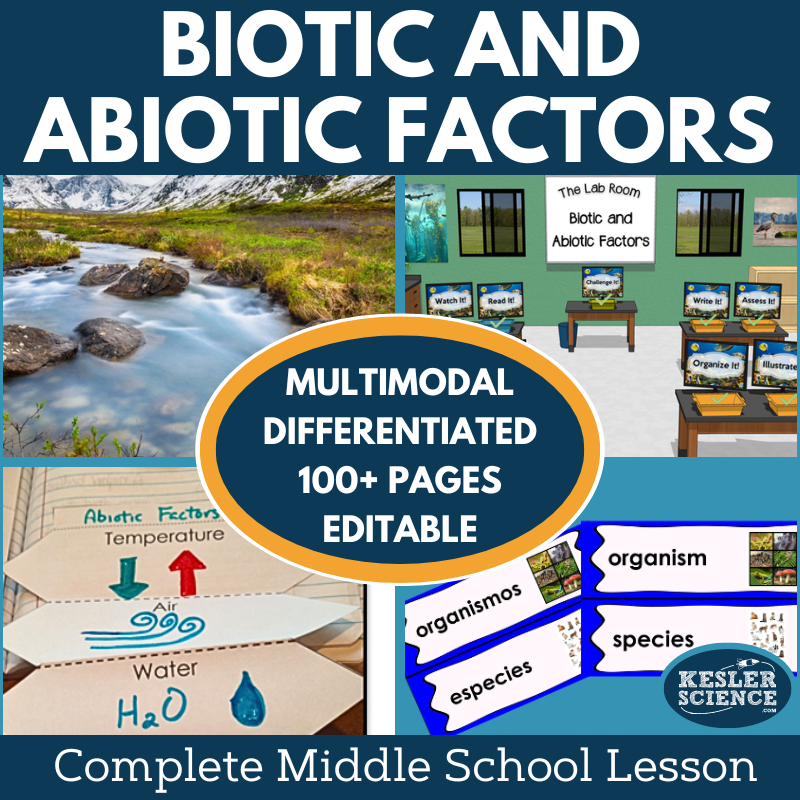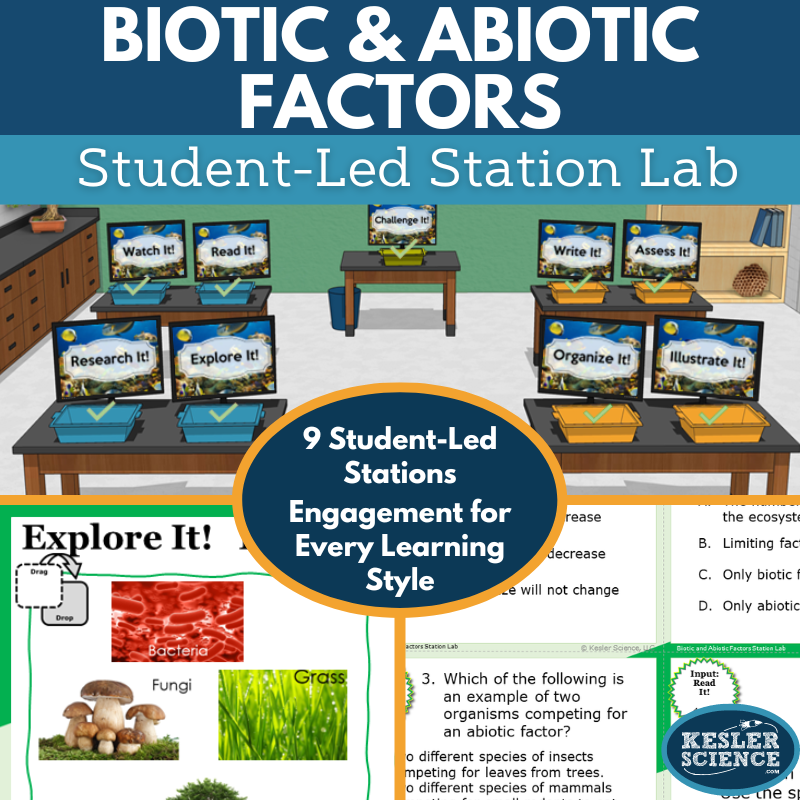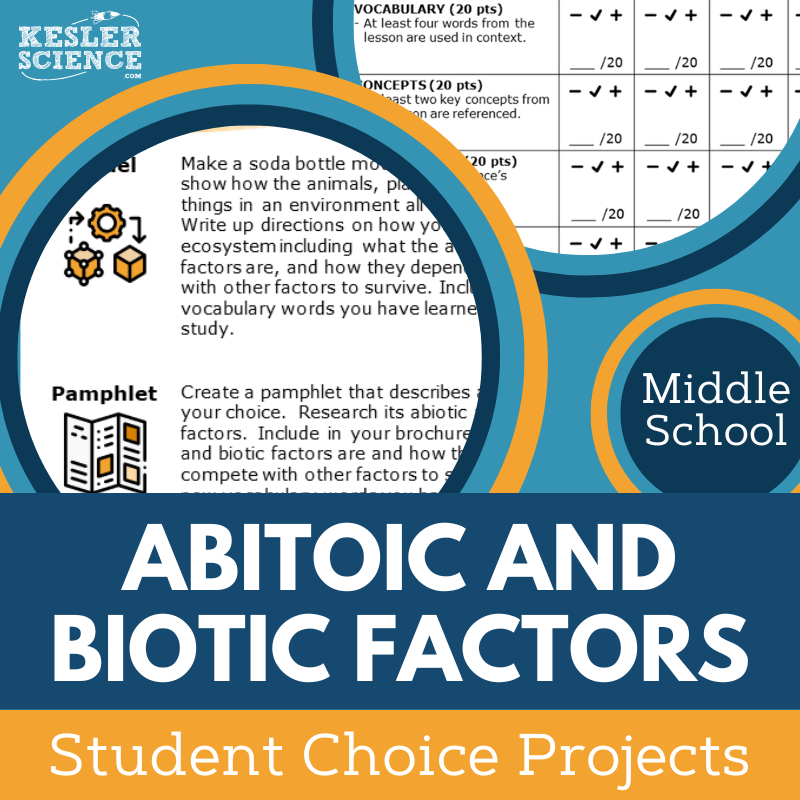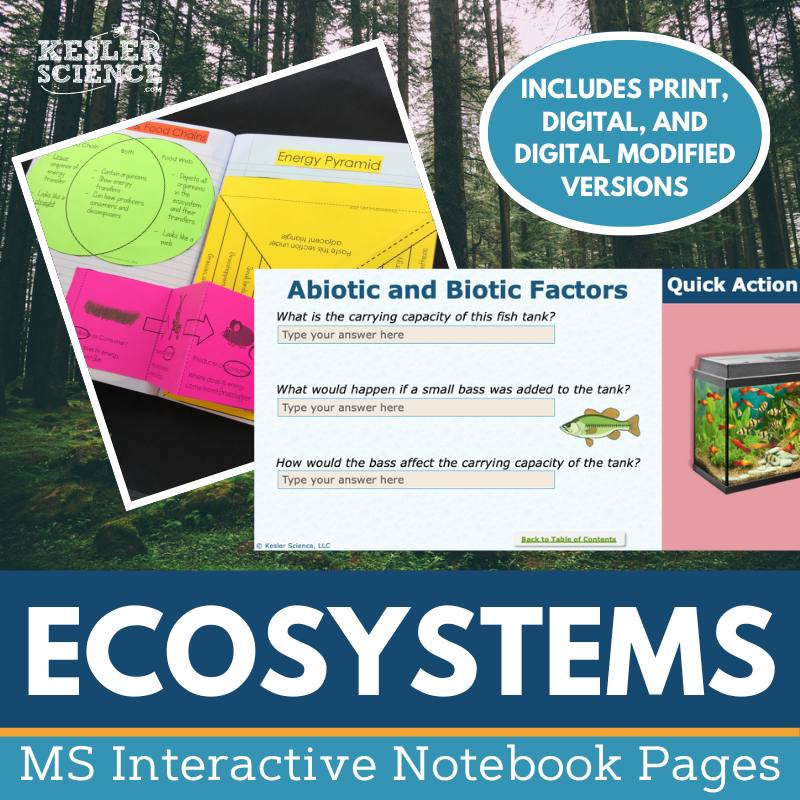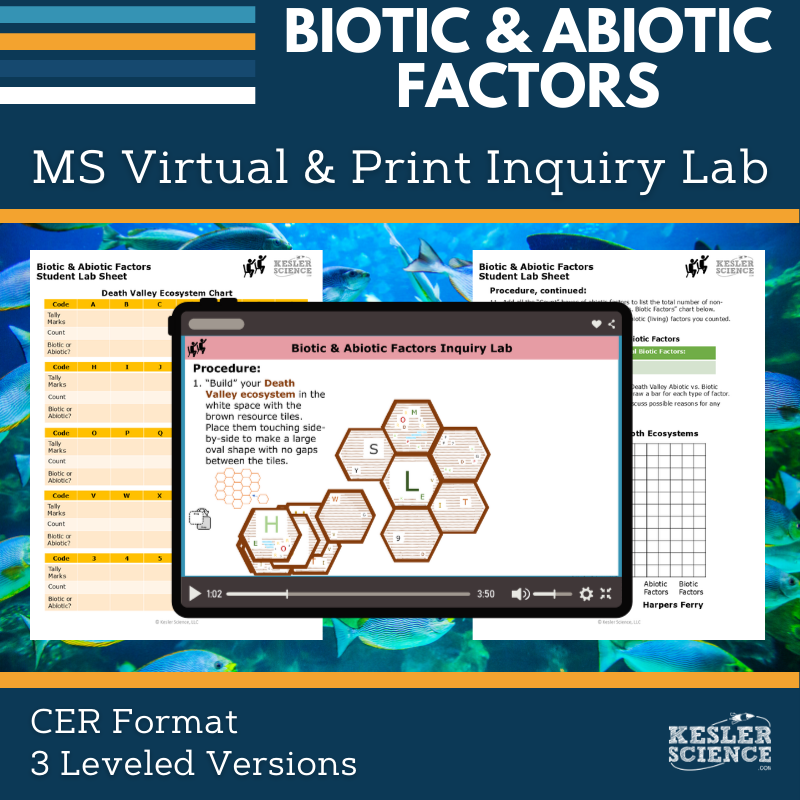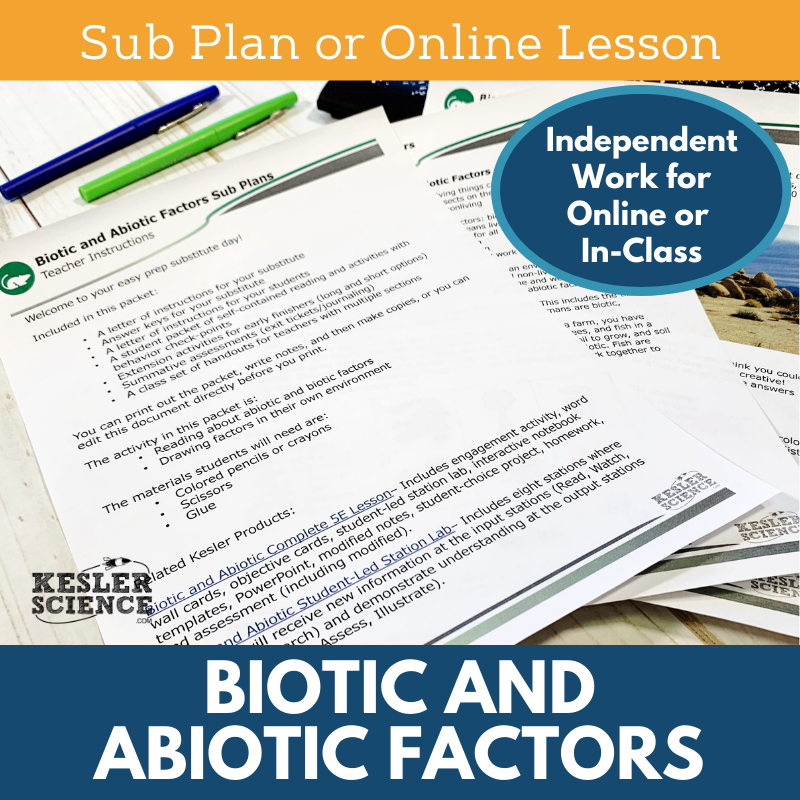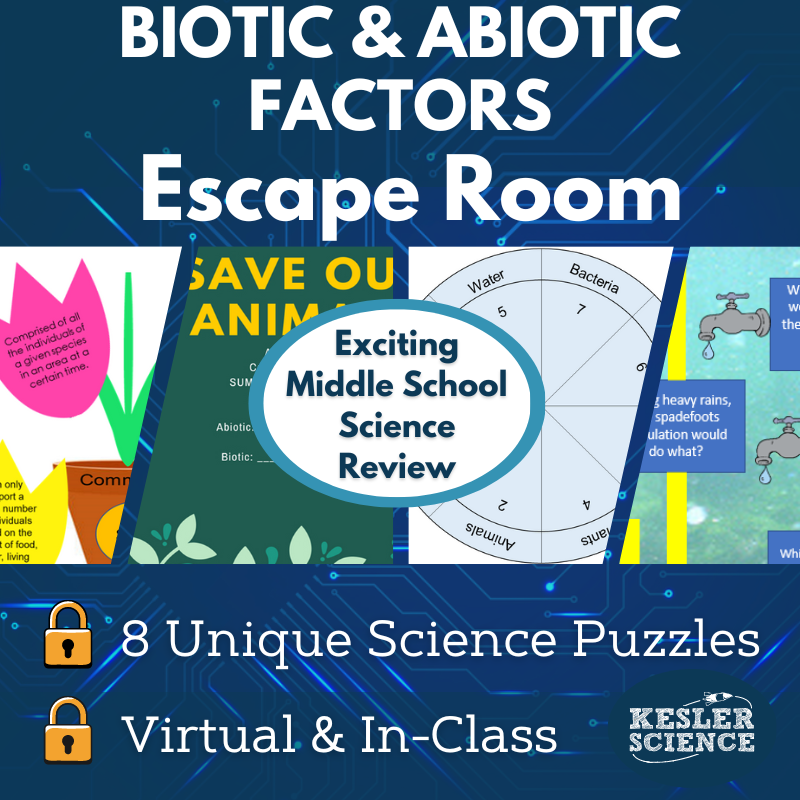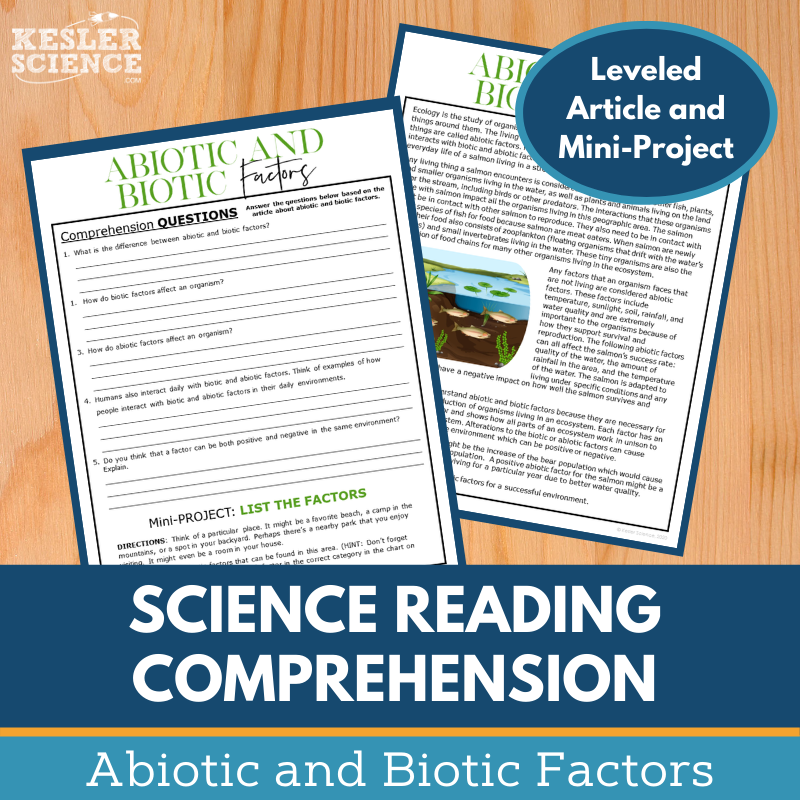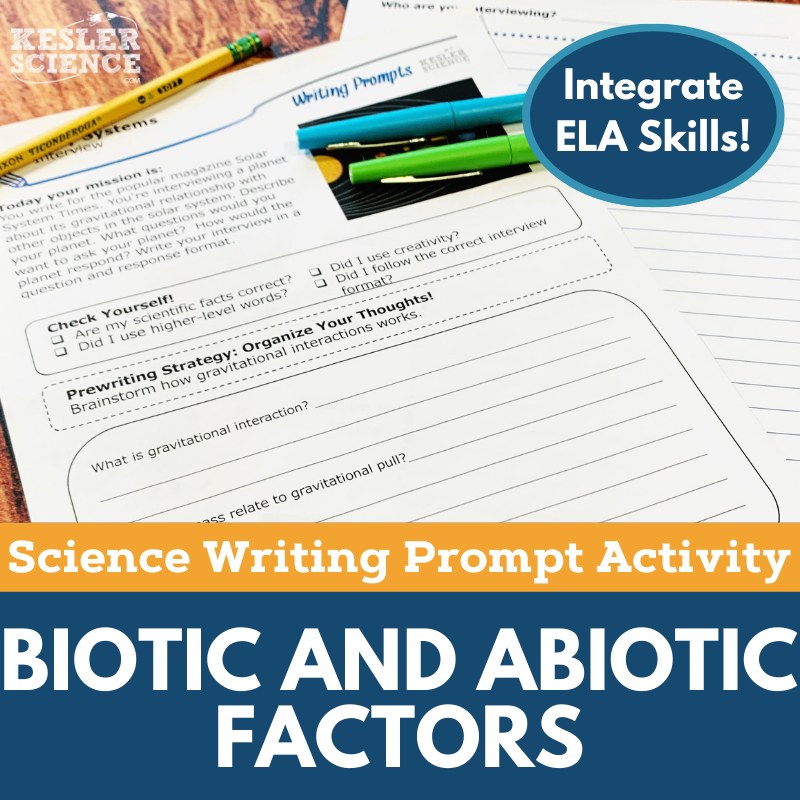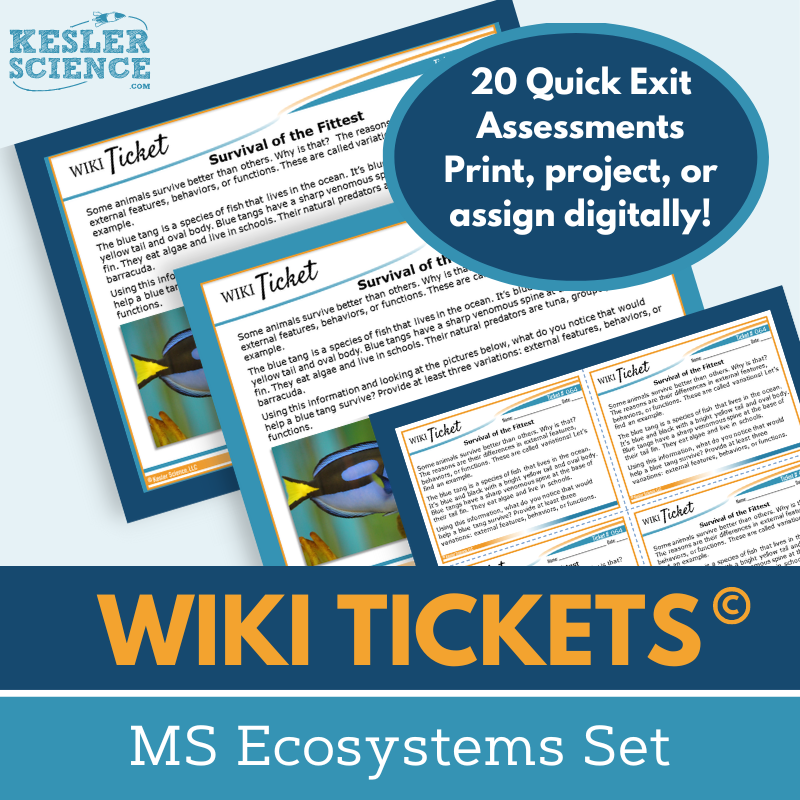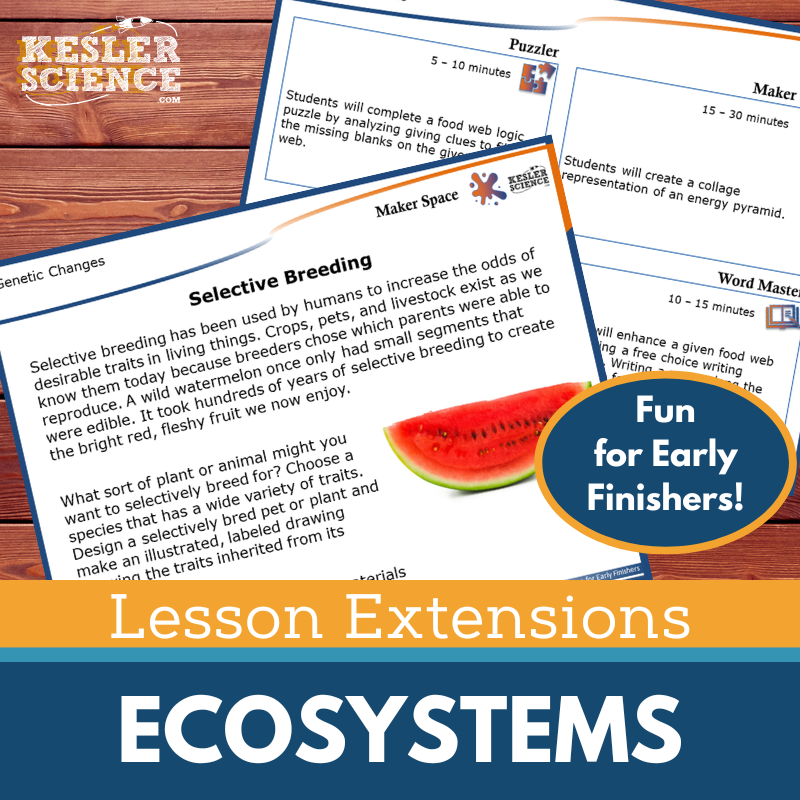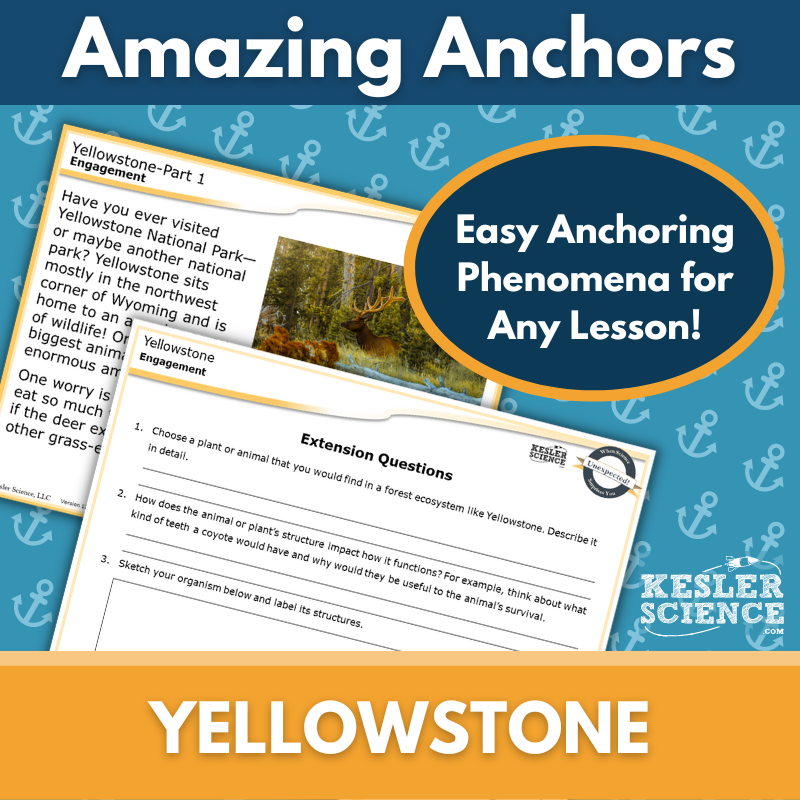Abiotic and Biotic Factors Activities for Middle School Science
Kesler Science Biotic and Abiotic Factors resources provide a comprehensive, engaging approach to teaching middle school students about the living and non-living components of ecosystems. The resources below will give students a comprehensive understanding of abiotic and biotic factors. All of the following materials are also included in the Kesler Science Membership.
The Kesler Science Biotic and Abiotic Complete 5E Lesson provides everything you need for an engaging, student-led lesson on ecosystems. It includes differentiated materials to support diverse learners and a variety of multimodal activities to keep middle school students engaged. This flexible lesson can be used in both printable and digital formats, and includes editable PowerPoints and Spanish translations for key vocabulary.
Structured around the 5E Model—Engagement, Exploration, Explanation, Elaboration, and Evaluation—this lesson covers all aspects of learning. Students start with engagement activities like word wall cards and class discussions, followed by the Exploration phase where they work through differentiated input and output stations. The Exploration stations allow students to engage with content in different ways through reading, researching, watching videos, and hands-on activities.
In the Elaboration phase, students deepen their understanding through student-choice projects, and the lesson wraps up with an Evaluation phase that includes standards-aligned assessment questions. This complete lesson is perfect for both in-person and virtual learning environments, offering flexibility for a variety of teaching settings.
The Kesler Science Biotic and Abiotic Complete 5E Lesson provides everything you need for an engaging, student-led lesson on ecosystems. It includes differentiated materials to support diverse learners and a variety of multimodal activities to keep middle school students engaged. This flexible lesson can be used in both printable and digital formats, and includes editable PowerPoints and Spanish translations for key vocabulary.
Structured around the 5E Model—Engagement, Exploration, Explanation, Elaboration, and Evaluation—this lesson covers all aspects of learning. Students start with engagement activities like word wall cards and class discussions, followed by the Exploration phase where they work through differentiated input and output stations. The Exploration stations allow students to engage with content in different ways through reading, researching, watching videos, and hands-on activities.
In the Elaboration phase, students deepen their understanding through student-choice projects, and the lesson wraps up with an Evaluation phase that includes standards-aligned assessment questions. This complete lesson is perfect for both in-person and virtual learning environments, offering flexibility for a variety of teaching settings.
The Kesler Science Biotic and Abiotic Factors Station Lab is a student-led activity that engages middle school learners by allowing them to explore ecosystems independently. With eight differentiated stations and a challenge station for early finishers, this lab provides a student-centered experience where the teacher facilitates learning rather than directing it.
The stations cover various aspects of biotic and abiotic factors through multimodal activities. Students will explore, research, read, and watch content at stations like "Explore It!", "Research It!", and "Watch It!". They will also showcase their learning through hands-on activities like "Organize It!", "Illustrate It!", and "Write It!". The “Assess It!” station allows them to demonstrate their understanding, while the bonus “Challenge It!” station provides advanced students with additional tasks.
These modular stations include all necessary materials, signage, and resources, making setup easy and minimal. The lab is flexible for both in-person and virtual settings, with digital options for students to manipulate images and text in PowerPoint or Google Slides.
The Kesler Science Biotic and Abiotic Factors Station Lab is a student-led activity that engages middle school learners by allowing them to explore ecosystems independently. With eight differentiated stations and a challenge station for early finishers, this lab provides a student-centered experience where the teacher facilitates learning rather than directing it.
The stations cover various aspects of biotic and abiotic factors through multimodal activities. Students will explore, research, read, and watch content at stations like "Explore It!", "Research It!", and "Watch It!". They will also showcase their learning through hands-on activities like "Organize It!", "Illustrate It!", and "Write It!". The “Assess It!” station allows them to demonstrate their understanding, while the bonus “Challenge It!” station provides advanced students with additional tasks.
These modular stations include all necessary materials, signage, and resources, making setup easy and minimal. The lab is flexible for both in-person and virtual settings, with digital options for students to manipulate images and text in PowerPoint or Google Slides.
The Kesler Science Biotic and Abiotic Factors Student Choice Projects allow middle school students to showcase their understanding through creative, personalized project options. Students choose from six distinct projects or design their own, with a rubric included for teacher, peer, or self-assessment. The multimodal approach ensures that each student can find a method to express their learning effectively.
With nine project options and a “design your own” feature, this lesson is flexible and adaptable. A teacher directions page and editable rubrics help streamline grading, while differentiated project versions cater to various student needs. For advanced learners, combining projects provides an extra challenge while maintaining consistency in evaluation.
The projects require common classroom materials like paper, markers, and scissors, with optional crafting supplies for model-building. Many tasks can also be completed digitally, ensuring accessibility for all students. This resource offers dynamic, engaging ways for students to explore biotic and abiotic factors while building creativity and confidence.
The Kesler Science Biotic and Abiotic Factors Student Choice Projects allow middle school students to showcase their understanding through creative, personalized project options. Students choose from six distinct projects or design their own, with a rubric included for teacher, peer, or self-assessment. The multimodal approach ensures that each student can find a method to express their learning effectively.
With nine project options and a “design your own” feature, this lesson is flexible and adaptable. A teacher directions page and editable rubrics help streamline grading, while differentiated project versions cater to various student needs. For advanced learners, combining projects provides an extra challenge while maintaining consistency in evaluation.
The projects require common classroom materials like paper, markers, and scissors, with optional crafting supplies for model-building. Many tasks can also be completed digitally, ensuring accessibility for all students. This resource offers dynamic, engaging ways for students to explore biotic and abiotic factors while building creativity and confidence.
The Kesler Science Ecosystems Interactive Notebook Bundle provides an engaging and interactive way for students to explore key ecosystems concepts. Designed for flexibility, the resource includes both print and digital versions, making it suitable for traditional classrooms, 1:1 environments, and distance learning settings.
The bundle covers a wide range of topics, including biotic and abiotic factors, biomes, food webs, symbiosis, and the nitrogen and carbon cycles. Digital features include a unique interactive notebook PowerPoint, editable Google Slides compatibility, reflection pages, and modified versions for students with accommodations. The paper version includes blank and pre-filled templates, complete with color examples to guide students and teachers.
This resource supports differentiated instruction and accommodates all learners with thoughtfully designed templates and modifications. Whether in person or online, the Ecosystems Interactive Notebook promotes active learning, critical thinking, and scientific literacy.
The Kesler Science Ecosystems Interactive Notebook Bundle provides an engaging and interactive way for students to explore key ecosystems concepts. Designed for flexibility, the resource includes both print and digital versions, making it suitable for traditional classrooms, 1:1 environments, and distance learning settings.
The bundle covers a wide range of topics, including biotic and abiotic factors, biomes, food webs, symbiosis, and the nitrogen and carbon cycles. Digital features include a unique interactive notebook PowerPoint, editable Google Slides compatibility, reflection pages, and modified versions for students with accommodations. The paper version includes blank and pre-filled templates, complete with color examples to guide students and teachers.
This resource supports differentiated instruction and accommodates all learners with thoughtfully designed templates and modifications. Whether in person or online, the Ecosystems Interactive Notebook promotes active learning, critical thinking, and scientific literacy.
The Biotic and Abiotic Factors Inquiry Lab aligns with NGSS standards by guiding students to classify and compare living and nonliving components of two distinct ecosystems: the hot desert of Death Valley and the temperate forest of Harpers Ferry. Students will build models of these biomes using resource tiles and then conduct line transects to identify abiotic and biotic factors. They will analyze and compare the data collected to understand how extreme and nonextreme environments differ in their balance of these factors.
This resource is offered in both print and digital formats, each with three differentiated versions—dependent, modified, and independent—to meet diverse learning needs. Students can engage in the lab through hands-on materials or follow along with a virtual demonstration featuring a video-recorded procedure. Reflection questions and prompts for Claim-Evidence-Reasoning (C.E.R.) statements are included to deepen understanding and support scientific thinking.
The lab requires minimal materials for the printed version, such as a magnifying glass, string, and resource pages. The digital version is fully interactive and designed for flexible classroom use, including compatibility with Google Slides, Schoology, and Canvas. Teacher resources like editable files, answer keys, and instructional guidance are also included to streamline implementation and support instructional goals.
The Biotic and Abiotic Factors Inquiry Lab aligns with NGSS standards by guiding students to classify and compare living and nonliving components of two distinct ecosystems: the hot desert of Death Valley and the temperate forest of Harpers Ferry. Students will build models of these biomes using resource tiles and then conduct line transects to identify abiotic and biotic factors. They will analyze and compare the data collected to understand how extreme and nonextreme environments differ in their balance of these factors.
This resource is offered in both print and digital formats, each with three differentiated versions—dependent, modified, and independent—to meet diverse learning needs. Students can engage in the lab through hands-on materials or follow along with a virtual demonstration featuring a video-recorded procedure. Reflection questions and prompts for Claim-Evidence-Reasoning (C.E.R.) statements are included to deepen understanding and support scientific thinking.
The lab requires minimal materials for the printed version, such as a magnifying glass, string, and resource pages. The digital version is fully interactive and designed for flexible classroom use, including compatibility with Google Slides, Schoology, and Canvas. Teacher resources like editable files, answer keys, and instructional guidance are also included to streamline implementation and support instructional goals.
The Kesler Science Biotic and Abiotic Factors Sub Plan is a comprehensive lesson designed to simplify your day out of the classroom. Students start with a warm-up, read an engaging passage, and complete an activity to categorize abiotic and biotic factors using rainforest and desert ecosystems. Early finishers can extend their learning by drawing a local ecosystem or engaging in a creative game, while an exit ticket or assessment wraps up the lesson.
This sub plan is perfect for both in-class and remote settings, featuring extensive substitute instructions, student PDF handouts, and a Google Form for digital assessments. With editable documents and behavior checkpoints, the resource ensures a seamless experience for substitutes, students, and teachers alike. Downtime is minimized with engaging, student-centered activities designed to keep learners on task.
Ideal for a variety of uses, the sub plan works as a standalone lesson, extra credit, or ISS assignment. Whether you're in the classroom or facilitating remote learning, this resource provides everything you need to keep your students engaged and learning—even when you're away.
The Kesler Science Biotic and Abiotic Factors Sub Plan is a comprehensive lesson designed to simplify your day out of the classroom. Students start with a warm-up, read an engaging passage, and complete an activity to categorize abiotic and biotic factors using rainforest and desert ecosystems. Early finishers can extend their learning by drawing a local ecosystem or engaging in a creative game, while an exit ticket or assessment wraps up the lesson.
This sub plan is perfect for both in-class and remote settings, featuring extensive substitute instructions, student PDF handouts, and a Google Form for digital assessments. With editable documents and behavior checkpoints, the resource ensures a seamless experience for substitutes, students, and teachers alike. Downtime is minimized with engaging, student-centered activities designed to keep learners on task.
Ideal for a variety of uses, the sub plan works as a standalone lesson, extra credit, or ISS assignment. Whether you're in the classroom or facilitating remote learning, this resource provides everything you need to keep your students engaged and learning—even when you're away.
The Kesler Science Biotic and Abiotic Factors Escape Room offers an immersive and engaging way for students to showcase their knowledge of biotic and abiotic factors, as well as limiting factors, through interactive puzzles. With eight independent puzzles, teachers can customize the experience by selecting which puzzles to use and the order in which they are presented, making it adaptable for various class lengths and schedules.
The escape room can be set up with simple materials like manila envelopes or enhanced with locks, hasps, and UV pens for a more authentic experience. A digital version is also included, allowing students to complete the activity remotely through PowerPoint or Google Slides. All puzzles come with detailed instructions, answer keys, and digital options, ensuring flexibility for in-person or virtual classrooms.
This resource includes teacher directions, a video challenge, printable props, reward templates, and over 50 prize ideas to make the activity unforgettable. Whether in the classroom or online, this escape room provides an exciting and collaborative way to reinforce key science concepts. Students will be talking about this adventure for weeks!
The Kesler Science Biotic and Abiotic Factors Escape Room offers an immersive and engaging way for students to showcase their knowledge of biotic and abiotic factors, as well as limiting factors, through interactive puzzles. With eight independent puzzles, teachers can customize the experience by selecting which puzzles to use and the order in which they are presented, making it adaptable for various class lengths and schedules.
The escape room can be set up with simple materials like manila envelopes or enhanced with locks, hasps, and UV pens for a more authentic experience. A digital version is also included, allowing students to complete the activity remotely through PowerPoint or Google Slides. All puzzles come with detailed instructions, answer keys, and digital options, ensuring flexibility for in-person or virtual classrooms.
This resource includes teacher directions, a video challenge, printable props, reward templates, and over 50 prize ideas to make the activity unforgettable. Whether in the classroom or online, this escape room provides an exciting and collaborative way to reinforce key science concepts. Students will be talking about this adventure for weeks!
The Kesler Science Biotic and Abiotic Factors Reading Comprehension activity on biotic and abiotic factors combines reading comprehension with hands-on learning to deepen students’ understanding of ecosystems. Students read a nonfiction article about the interactions between biotic and abiotic components, answer comprehension questions, and classify factors from an environment. Designed for grades 6-8 (and advanced 5th graders), the leveled articles (Lexile 1100-1300) support science literacy while fostering critical thinking.
Each passage includes 5-7 comprehension questions, a hands-on mini-project, and optional Cornell notes templates to help students organize information. Colorful, printable graphics make the material visually engaging, and all resources are available in digital formats for use in Google Classroom, MS Teams, or other LMS platforms. This flexibility allows students to work on campus or remotely, making the lesson ideal for distance learning, absences, or sub plans.
These reading comprehension activities are perfect for building science literacy, facilitating class discussions, and reinforcing textual analysis skills. Teachers can use them as part of a routine, for extra credit, or as part of whole-class instruction. With opportunities for hands-on interaction and flexible formats, this resource supports a variety of learning environments and styles.
The Kesler Science Biotic and Abiotic Factors Reading Comprehension activity on biotic and abiotic factors combines reading comprehension with hands-on learning to deepen students’ understanding of ecosystems. Students read a nonfiction article about the interactions between biotic and abiotic components, answer comprehension questions, and classify factors from an environment. Designed for grades 6-8 (and advanced 5th graders), the leveled articles (Lexile 1100-1300) support science literacy while fostering critical thinking.
Each passage includes 5-7 comprehension questions, a hands-on mini-project, and optional Cornell notes templates to help students organize information. Colorful, printable graphics make the material visually engaging, and all resources are available in digital formats for use in Google Classroom, MS Teams, or other LMS platforms. This flexibility allows students to work on campus or remotely, making the lesson ideal for distance learning, absences, or sub plans.
These reading comprehension activities are perfect for building science literacy, facilitating class discussions, and reinforcing textual analysis skills. Teachers can use them as part of a routine, for extra credit, or as part of whole-class instruction. With opportunities for hands-on interaction and flexible formats, this resource supports a variety of learning environments and styles.
The Kesler Science Biotic and Abiotic Factors Science Writing Prompt Activity uses poetry to engage middle school students in exploring life science concepts creatively. This fun, student-centered activity encourages science reasoning and enriches writing skills while working seamlessly in virtual or in-person classrooms. Designed to complement other Kesler Science products, it’s perfect for elaboration, review, or stand-alone exploration.
This low-prep resource includes teacher directions with rubrics, project ideas, and answer guides, along with full- and half-sheet handouts for flexible use. A digital version in PowerPoint or Google Slides makes it easy to assign and complete in remote settings. The handouts include prompts, self-checks, pre-writing strategies, and templates, allowing students to focus on expressing their understanding of biotic and abiotic factors through poetry.
The writing prompt activity is ideal for cross-curricular projects, formative assessments, early finisher tasks, extra credit, or differentiation exercises. It can also be used as a TELPAS sample, student-choice project, or make-up work, providing creative and rigorous opportunities for all learners.
The Kesler Science Biotic and Abiotic Factors Science Writing Prompt Activity uses poetry to engage middle school students in exploring life science concepts creatively. This fun, student-centered activity encourages science reasoning and enriches writing skills while working seamlessly in virtual or in-person classrooms. Designed to complement other Kesler Science products, it’s perfect for elaboration, review, or stand-alone exploration.
This low-prep resource includes teacher directions with rubrics, project ideas, and answer guides, along with full- and half-sheet handouts for flexible use. A digital version in PowerPoint or Google Slides makes it easy to assign and complete in remote settings. The handouts include prompts, self-checks, pre-writing strategies, and templates, allowing students to focus on expressing their understanding of biotic and abiotic factors through poetry.
The writing prompt activity is ideal for cross-curricular projects, formative assessments, early finisher tasks, extra credit, or differentiation exercises. It can also be used as a TELPAS sample, student-choice project, or make-up work, providing creative and rigorous opportunities for all learners.
The Kesler Science Ecosystems WIKI Tickets are versatile formative assessments designed for 6th-8th grade science topics. These engaging assessments come in five formats for each topic: full screen for projection, three handout sizes (full, split, and quarter-page), and a digital interactive version that can be used as an editable PPT or Google Slides file. Perfect for checking understanding, these WIKI Tickets provide flexible options for in-person and virtual learning environments.
Aligned with NGSS and TEKS standards, each WIKI Tickets set includes a variety of topics like biodiversity, ecosystems, photosynthesis, and human impact. A bonus table of contents helps teachers quickly find the alignment for each standard. Some topics even have multiple tickets to reinforce key concepts and support student learning.
These assessments are ideal for use as exit tickets, bellringers, or anytime you need quick feedback on student progress. With digital and print formats available, they can be easily adapted for any classroom setting, providing a fun and effective way to gauge students' understanding of science concepts.
The Kesler Science Ecosystems WIKI Tickets are versatile formative assessments designed for 6th-8th grade science topics. These engaging assessments come in five formats for each topic: full screen for projection, three handout sizes (full, split, and quarter-page), and a digital interactive version that can be used as an editable PPT or Google Slides file. Perfect for checking understanding, these WIKI Tickets provide flexible options for in-person and virtual learning environments.
Aligned with NGSS and TEKS standards, each WIKI Tickets set includes a variety of topics like biodiversity, ecosystems, photosynthesis, and human impact. A bonus table of contents helps teachers quickly find the alignment for each standard. Some topics even have multiple tickets to reinforce key concepts and support student learning.
These assessments are ideal for use as exit tickets, bellringers, or anytime you need quick feedback on student progress. With digital and print formats available, they can be easily adapted for any classroom setting, providing a fun and effective way to gauge students' understanding of science concepts.
The Kesler Science Ecosystems Lesson Extensions offer student-choice activities to challenge fast finishers and encourage critical thinking. These activities provide engaging ways to deepen learning and can be used to wrap up lessons, prevent distractions, or fill gaps during testing. Each extension is designed to scaffold learning with activities that align with NGSS and TEKS standards, making them perfect for students ready to explore topics like ecosystems in more depth.
Included in each Lesson Extension are four activity types: Puzzler, Maker Space, Tech Connection, and Word Master. These activities focus on problem-solving, STEAM connections, digital media, and creative writing, providing opportunities for students to apply their knowledge in diverse and engaging ways. Both digital and paper versions are available, with teacher directions and answer keys for easy implementation.
These extensions are ideal for pushing independent learners further, offering rigorous, fun, and hands-on learning opportunities. With topics ranging from biodiversity to ecosystems and environmental changes, these resources help extend students' understanding of science concepts while reinforcing critical skills.
The Kesler Science Ecosystems Lesson Extensions offer student-choice activities to challenge fast finishers and encourage critical thinking. These activities provide engaging ways to deepen learning and can be used to wrap up lessons, prevent distractions, or fill gaps during testing. Each extension is designed to scaffold learning with activities that align with NGSS and TEKS standards, making them perfect for students ready to explore topics like ecosystems in more depth.
Included in each Lesson Extension are four activity types: Puzzler, Maker Space, Tech Connection, and Word Master. These activities focus on problem-solving, STEAM connections, digital media, and creative writing, providing opportunities for students to apply their knowledge in diverse and engaging ways. Both digital and paper versions are available, with teacher directions and answer keys for easy implementation.
These extensions are ideal for pushing independent learners further, offering rigorous, fun, and hands-on learning opportunities. With topics ranging from biodiversity to ecosystems and environmental changes, these resources help extend students' understanding of science concepts while reinforcing critical skills.
The Amazing Anchors Phenomenon Lesson introduces and reinforces the concept of biotic and abiotic factors through the lens of the Yellowstone ecosystem. Students begin with an engaging introductory reading that explores real-world relationships in Yellowstone, followed by comprehension and extension questions to build background knowledge. A second explanatory reading breaks down the science behind these ecological factors, helping students understand how living and nonliving components interact in this unique environment.
The resource includes everything needed to support instruction, including teacher directions, answer keys, editable slides for projection, and both digital and paper handouts. Materials are fully aligned to TEKS standards and are provided in full- and half-sheet formats to fit interactive notebooks or digital platforms. A modified version with sentence starters is also included to support diverse learners.
Designed to supplement any core lesson, this no-prep resource is ideal for the Engagement and Elaboration phases of the 5E model. It works well in both in-person and virtual classrooms, giving students a meaningful, real-world anchor for understanding biotic and abiotic factors.
The Amazing Anchors Phenomenon Lesson introduces and reinforces the concept of biotic and abiotic factors through the lens of the Yellowstone ecosystem. Students begin with an engaging introductory reading that explores real-world relationships in Yellowstone, followed by comprehension and extension questions to build background knowledge. A second explanatory reading breaks down the science behind these ecological factors, helping students understand how living and nonliving components interact in this unique environment.
The resource includes everything needed to support instruction, including teacher directions, answer keys, editable slides for projection, and both digital and paper handouts. Materials are fully aligned to TEKS standards and are provided in full- and half-sheet formats to fit interactive notebooks or digital platforms. A modified version with sentence starters is also included to support diverse learners.
Designed to supplement any core lesson, this no-prep resource is ideal for the Engagement and Elaboration phases of the 5E model. It works well in both in-person and virtual classrooms, giving students a meaningful, real-world anchor for understanding biotic and abiotic factors.
Year-Round Resources
These year-round activities will increase your students' understanding of many middle school science topics. All of these activities are also included in the Kesler Science Membership.
Visual Data & Graphing
You're not alone if your students struggle with understanding graphs, charts, and tables. It's a skill that takes an enormous amount of practice. This resource will help students build a strong foundation in analyzing data and creating their own data visualizations.
Bell Ringers and Warm-Ups
These middle school science bell ringers are an excellent way to engage your students as soon as they walk into your classroom. This comprehensive FULL YEAR resource includes everything you need to start off each science class with an interesting warm-up activity.
Review Board Games
Each game board has been carefully designed to keep students engaged. There are 10 different action spaces on each board and dozens of question cards. All of the actions are related to science concepts and keep the students motivated throughout the game.
Each game is ready to play. Simply print out the board and the cards and let the students enjoy reviewing nine different units.
Essential Questions
Below are the essential questions associated with the lessons and activities included in this unit. This topic is only one of more than 100 middle school science topics included in the Kesler Science Membership.
-
What are the biotic and abiotic parts of an ecosystem?
-
How do organisms and populations in an ecosystem depend on and compete for biotic and abiotic factors?
Kesler Science Membership
Imagine never having to search for another middle school science lesson again. The membership gives you access to ALL of the Kesler Science products in one place (Yes, including everything above).
Say goodbye to long hours of lesson prep.

